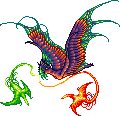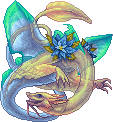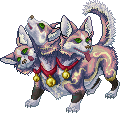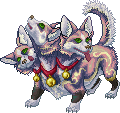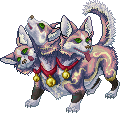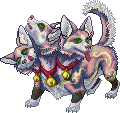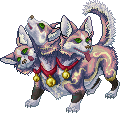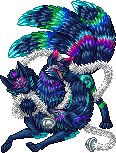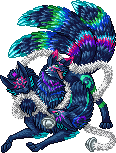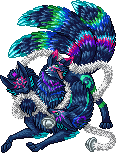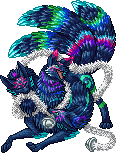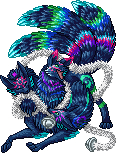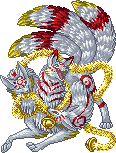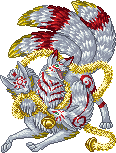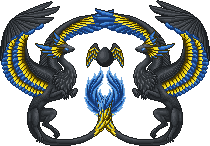Did anyone found anything? c:
--------------------------------------------
NEW Quest
Preservationist: The Symposium
Location: Triathe
Spoiler
A warm breeze wafts through the slatted windows on the lower level of the Tower of Triathe. As it winds around a series of pipes through which water is pumped to the upper floors, it cools considerably and wafts gently at your face. The scholars of Triathe are renowned for their inventions, many of which are displayed today at the Tower in celebration of its founding. Students of all ages, independent inventors, artists, merchants, and even a few magi from the east flood the lower levels of the Tower with displays and stands to advertise their year's accomplishments. You pass a dense cluster of artisans watching a printer's demonstration, then your eye becomes distracted by an intricate wind chime that makes a sound like no other you've ever heard. The inventor beams at the row of fascinated children who have gathered for a closer look, and changes the music drastically with a few delicate taps to parts of the instrument.
The music is momentarily interrupted by a bird-like caw, and suddenly your attention is focused to a small booth nestled in a corner of the room. There are almost no animals at this event -- unsurprising as even in Triathe, most magical creatures are viewed with apprehension. The sole person at this booth has two creatures in her care -- a mammoth snail making a gradual break at freedom by crawling to the end of the table, and a feathery creature perched on a stand that you eventually recognize as a tsaanguir. The booth operator offers the tsaanguir a piece of meat from her gloved hand, but the creature eyes you attentively. You have never seen either animal in Alveus before. Even at the Keep, they're rare.
The caretaker turns and seems surprised to see you, but recovers and waves at you warmly. "Hello there, would you like to learn about the Museum of Rare Beasts?" she asks, welcoming you to the contents of her booth. Aside from the creatures, there are fossils of all sorts, charts, diagrams, and maps -- some for sale, but most simply for display.
She offers you a little scroll with a map of the city and an emblem of a tree. Next to it are the words "The Preservationists Association Welcomes You to the Grand Opening of the Museum of Rare Beasts!"
"The Preservationists Association?" you ask.
The woman nods. "We've been around for a while -- a small group at the moment, but always growing larger. We've just secured funding for our new headquarters so our founders thought, why not put our findings on display? Hence, the Museum of Rare Beasts."
"What do you guys do there?" you ask, looking at the contents of the booth and then glancing at the mammoth snail as it starts to slide down one of the table's corners.
The booth attendant rescues the overly-curious snail and places it in a wooden box full of leaves and hay. "Well," she says, "we're mainly dedicated to breeding and raising creatures that are at risk of going extinct, but we do a lot of things really. We send out expeditions to certain areas to study the creatures that live there, and we also look at the fossils of creatures from extinct environments. A lot of the animals we have around today are relics of ancient ecosystems, so by studying the regions their ancestors lived in, we can better understand what the living creatures need. We're also the repository of much of Alveus' knowledge of natural history."
Some of the children who were previously watching the wind chime cautiously crowd around the booth, mesmerized by the creatures. A few pick up stone fossils that resemble shells. The attendant moves the tsaanguir to a perch where it begins to preen its feathers, then turns toward the children and offers them some hay to feed the hungry mammoth snail.
As you turn to leave, the woman calls back, "Feel free to stop by the museum if you like -- ask for Director Allisand and tell him Jaca sent you. He can tell you more about our Association."
=====
The museum is located in the old part of town where the buildings are rarely more than two stories tall and the roads are paved with tightly-knit cobbles worn smooth from countless years and boots. You follow the map Jaca gave you until you reach a building with a large maple tree planted out front and a golden banner strung around it, reading: The Museum of Rare Beasts.
The building seems to have once been someone's elegant house, surrounded by a garden full of immense boulders. The walkway winds around them The rocks are all different textures and colors, and as you pass by, you notice many of them have tiny fossils shells embedded within. You approach one of the boulders and trace the remnants of what looks like part of a tiny palm tree.
A melodic whistle alerts you to the presence of other occupants of the yard besides fellow visitors as a large crested head leans over the boulder to get a look at you. The creature is red and gray with a dragonish face, a rippling wattle, and a pair of frills running down its neck. It chirrups at you, making marvelous noises that seem far too delicate for a creature easily larger than an elephant. The creature, a frilled cazaui if you remember your texts correctly, sniffs the air a few times before moving on, lumbering slowly toward a group of unsuspecting guests offering treats to some kalistavri.
Looking around more carefully, you realize there are quite a few creatures in the vast yard. A small herd of latifra beasts graze in a paddock at the rear of the yard, separated by a fence of boulders set too close for their elongate horns to pass through. Torreks scamper around the ground, while the trees are crowded with all manner of kalistavri and a few larger raznaks. The cazaui who came to investigate you is easily the largest animal around, likely the largest in the city at the moment. You wonder how its caretakers manage to keep it from stripping the trees in the yard bare.
As guests funnel in through the doors, you remember that you're here to see Director Allisand. You follow the crowd and are greeted with a spectacular entrance hall fitted with a glass ceiling and a grand staircase. There are mounts of ancient skeletons, some of creatures you recognize, but many unfamiliar. Each skeleton has a small gold placard with information about the creatures, including where they came from. You're surprised and somewhat saddened to learn that several of the mounts belong to creatures that have long since vanished from the earth.
Up the stairs is the main gallery, which is filled with even larger skeletons and glass cases full of specimens. There are teeth, horns, skulls, pelts, and even animal mummies recovered from the coldest caves of the Alasres. The gallery is three levels tall and organized by the age of the rocks the creatures came from. The museum has specimens from all over the world, from the furthest corners of Voltar to Calidis, and even lands you've never heard of before.
You spend a few minutes marveling at the displays, the most impressive of which is a massive dragon skeleton hanging in a lifelike pose from the ceiling, suspended by magic. You're surprised to see the museum using magic so openly in the middle of Alveus, even a city like Triathe, but you recognize a few magi faces among the exhibit guides. You ask them to point you to the director and one of the guides leads you to a greenhouse at the back of the museum.
The rear of the building is designed to mimic the habitats of times long gone. Exotic plants adorn the walkways, which blend into the underbrush as you get further into the greenhouse. It seems to be mainly focused on plat life, but you spot a few small insects and other creatures hiding behind leaves. Most dart away when they detect your gaze, but when you run into a small spotted scorpion lounging on a piece of bark, you pause to examine it.
"Marvelous, isn't it? Araucarias used to be found all over this region in ages past, but the only living specimens come from far to the south in a tiny corner of the Ixan Jungle. This specimen was grown from a seed over a hundred years ago." An aging but energetic man with round glasses and a bristly mustache leans back to look at the tree. You notice for the first time how tall it is -- tall enough that it pokes out of the top of the greenhouse roof through a skylight. When you look back at the scorpion, you see it has started to clamber down toward a small caterpillar munching on some nearby leaves. You decide to leave it be.
"Are you Director Allisand?" you ask the man, noticing his uniform. He seems momentarily surprised, then holds out a hand.
"Doctor Allisand Shrio IV, at your service. Are you a new member of the Association?"
You explain that you would like to be and mention Jaca from the expo. He beams and excitedly starts to talk about the Preservationists Association. "Oh yes, we've recently opened up our breeding program for rare creatures, with the help of the Keep and the Tower. The Association is concerned with studying and preserving all the world's ecosystems and the life forms that inhabit them, but we're always in need of new caretakers to help raise and train creatures for eventual release. Given your experience as a magi, I imagine you would make a fine addition to the Association! Of course, I should warn you that the application process is a bit involved. We need to make sure members have the dedication to become caretakers. These creatures are harder to handle than most, and more delicate as well. You'll need a variety of harasses, work gloves, protective equipment, brushes, trimmers, blankets, and cleaning supplies -- not to mention feed. We can provide some of our own materials, but the museum is mostly run on donations. We ask that members contribute 5,000 gold if they want to be part of the Association itself, and by extension, the breeding program. You can bring it to the membership desk when you're ready."
The music is momentarily interrupted by a bird-like caw, and suddenly your attention is focused to a small booth nestled in a corner of the room. There are almost no animals at this event -- unsurprising as even in Triathe, most magical creatures are viewed with apprehension. The sole person at this booth has two creatures in her care -- a mammoth snail making a gradual break at freedom by crawling to the end of the table, and a feathery creature perched on a stand that you eventually recognize as a tsaanguir. The booth operator offers the tsaanguir a piece of meat from her gloved hand, but the creature eyes you attentively. You have never seen either animal in Alveus before. Even at the Keep, they're rare.
The caretaker turns and seems surprised to see you, but recovers and waves at you warmly. "Hello there, would you like to learn about the Museum of Rare Beasts?" she asks, welcoming you to the contents of her booth. Aside from the creatures, there are fossils of all sorts, charts, diagrams, and maps -- some for sale, but most simply for display.
She offers you a little scroll with a map of the city and an emblem of a tree. Next to it are the words "The Preservationists Association Welcomes You to the Grand Opening of the Museum of Rare Beasts!"
"The Preservationists Association?" you ask.
The woman nods. "We've been around for a while -- a small group at the moment, but always growing larger. We've just secured funding for our new headquarters so our founders thought, why not put our findings on display? Hence, the Museum of Rare Beasts."
"What do you guys do there?" you ask, looking at the contents of the booth and then glancing at the mammoth snail as it starts to slide down one of the table's corners.
The booth attendant rescues the overly-curious snail and places it in a wooden box full of leaves and hay. "Well," she says, "we're mainly dedicated to breeding and raising creatures that are at risk of going extinct, but we do a lot of things really. We send out expeditions to certain areas to study the creatures that live there, and we also look at the fossils of creatures from extinct environments. A lot of the animals we have around today are relics of ancient ecosystems, so by studying the regions their ancestors lived in, we can better understand what the living creatures need. We're also the repository of much of Alveus' knowledge of natural history."
Some of the children who were previously watching the wind chime cautiously crowd around the booth, mesmerized by the creatures. A few pick up stone fossils that resemble shells. The attendant moves the tsaanguir to a perch where it begins to preen its feathers, then turns toward the children and offers them some hay to feed the hungry mammoth snail.
As you turn to leave, the woman calls back, "Feel free to stop by the museum if you like -- ask for Director Allisand and tell him Jaca sent you. He can tell you more about our Association."
=====
The museum is located in the old part of town where the buildings are rarely more than two stories tall and the roads are paved with tightly-knit cobbles worn smooth from countless years and boots. You follow the map Jaca gave you until you reach a building with a large maple tree planted out front and a golden banner strung around it, reading: The Museum of Rare Beasts.
The building seems to have once been someone's elegant house, surrounded by a garden full of immense boulders. The walkway winds around them The rocks are all different textures and colors, and as you pass by, you notice many of them have tiny fossils shells embedded within. You approach one of the boulders and trace the remnants of what looks like part of a tiny palm tree.
A melodic whistle alerts you to the presence of other occupants of the yard besides fellow visitors as a large crested head leans over the boulder to get a look at you. The creature is red and gray with a dragonish face, a rippling wattle, and a pair of frills running down its neck. It chirrups at you, making marvelous noises that seem far too delicate for a creature easily larger than an elephant. The creature, a frilled cazaui if you remember your texts correctly, sniffs the air a few times before moving on, lumbering slowly toward a group of unsuspecting guests offering treats to some kalistavri.
Looking around more carefully, you realize there are quite a few creatures in the vast yard. A small herd of latifra beasts graze in a paddock at the rear of the yard, separated by a fence of boulders set too close for their elongate horns to pass through. Torreks scamper around the ground, while the trees are crowded with all manner of kalistavri and a few larger raznaks. The cazaui who came to investigate you is easily the largest animal around, likely the largest in the city at the moment. You wonder how its caretakers manage to keep it from stripping the trees in the yard bare.
As guests funnel in through the doors, you remember that you're here to see Director Allisand. You follow the crowd and are greeted with a spectacular entrance hall fitted with a glass ceiling and a grand staircase. There are mounts of ancient skeletons, some of creatures you recognize, but many unfamiliar. Each skeleton has a small gold placard with information about the creatures, including where they came from. You're surprised and somewhat saddened to learn that several of the mounts belong to creatures that have long since vanished from the earth.
Up the stairs is the main gallery, which is filled with even larger skeletons and glass cases full of specimens. There are teeth, horns, skulls, pelts, and even animal mummies recovered from the coldest caves of the Alasres. The gallery is three levels tall and organized by the age of the rocks the creatures came from. The museum has specimens from all over the world, from the furthest corners of Voltar to Calidis, and even lands you've never heard of before.
You spend a few minutes marveling at the displays, the most impressive of which is a massive dragon skeleton hanging in a lifelike pose from the ceiling, suspended by magic. You're surprised to see the museum using magic so openly in the middle of Alveus, even a city like Triathe, but you recognize a few magi faces among the exhibit guides. You ask them to point you to the director and one of the guides leads you to a greenhouse at the back of the museum.
The rear of the building is designed to mimic the habitats of times long gone. Exotic plants adorn the walkways, which blend into the underbrush as you get further into the greenhouse. It seems to be mainly focused on plat life, but you spot a few small insects and other creatures hiding behind leaves. Most dart away when they detect your gaze, but when you run into a small spotted scorpion lounging on a piece of bark, you pause to examine it.
"Marvelous, isn't it? Araucarias used to be found all over this region in ages past, but the only living specimens come from far to the south in a tiny corner of the Ixan Jungle. This specimen was grown from a seed over a hundred years ago." An aging but energetic man with round glasses and a bristly mustache leans back to look at the tree. You notice for the first time how tall it is -- tall enough that it pokes out of the top of the greenhouse roof through a skylight. When you look back at the scorpion, you see it has started to clamber down toward a small caterpillar munching on some nearby leaves. You decide to leave it be.
"Are you Director Allisand?" you ask the man, noticing his uniform. He seems momentarily surprised, then holds out a hand.
"Doctor Allisand Shrio IV, at your service. Are you a new member of the Association?"
You explain that you would like to be and mention Jaca from the expo. He beams and excitedly starts to talk about the Preservationists Association. "Oh yes, we've recently opened up our breeding program for rare creatures, with the help of the Keep and the Tower. The Association is concerned with studying and preserving all the world's ecosystems and the life forms that inhabit them, but we're always in need of new caretakers to help raise and train creatures for eventual release. Given your experience as a magi, I imagine you would make a fine addition to the Association! Of course, I should warn you that the application process is a bit involved. We need to make sure members have the dedication to become caretakers. These creatures are harder to handle than most, and more delicate as well. You'll need a variety of harasses, work gloves, protective equipment, brushes, trimmers, blankets, and cleaning supplies -- not to mention feed. We can provide some of our own materials, but the museum is mostly run on donations. We ask that members contribute 5,000 gold if they want to be part of the Association itself, and by extension, the breeding program. You can bring it to the membership desk when you're ready."
Spoiler
A short elderly woman in a fine suit peers over her spectacles as you approach. She smiles sweetly and asks how she can help you. You say you want to become a member of the Preservationists Association and place a sack of coins on the desk.
"Oh, how generous of you!" She takes down your name in golden ink and hands you a small rectangular token with the museum's insignia on it. The token has a clasp attached to it that reads: P.A. Member.
"You can use that to get in whenever you like, during operating hours of course. Now, I imagine you'll want to get started right away, but I'm afraid you're going to have to see our head breeder before you can get started. We require all new members of the Association check in with Professor Ward and help her with field work as part of their training. It familiarizes you with the sort of work we do here."
She hands you some boots and tools and draws you up a map with instructions to Professor Ward's field site. It looks like you're heading to Mountain Pass Junction.
"Oh, and one more thing!" the small lady at the desk says before you leave. "The terrain is not terribly forgiving. You'll want to bring some companions along, and, well, we've found that daeodus and albino nandi bears work best. One adult albino nandi bear should do, and three adult daeodus to help carry supplies. It'll prove you know how to handle the sort of creatures we take care of, anyway."
"Oh, how generous of you!" She takes down your name in golden ink and hands you a small rectangular token with the museum's insignia on it. The token has a clasp attached to it that reads: P.A. Member.
"You can use that to get in whenever you like, during operating hours of course. Now, I imagine you'll want to get started right away, but I'm afraid you're going to have to see our head breeder before you can get started. We require all new members of the Association check in with Professor Ward and help her with field work as part of their training. It familiarizes you with the sort of work we do here."
She hands you some boots and tools and draws you up a map with instructions to Professor Ward's field site. It looks like you're heading to Mountain Pass Junction.
"Oh, and one more thing!" the small lady at the desk says before you leave. "The terrain is not terribly forgiving. You'll want to bring some companions along, and, well, we've found that daeodus and albino nandi bears work best. One adult albino nandi bear should do, and three adult daeodus to help carry supplies. It'll prove you know how to handle the sort of creatures we take care of, anyway."
Preservationist: A Cold Challenge
Location: Mountain Pass Junction
Spoiler
The Mountain Pass Junction is a pleasant encampment about a day's hike from the research site. You stop there for the night and awake the next morning fresh to tackle the tricky route up. It's easy going at first, but quickly the path becomes less stable as you venture further into the wilderness.
Your companions at your side, a massive albino nandi bear and three wily daeodus, have large bodies that provide a little warmth in the cold mountains. The daeodus do not get along well and squeal at each other through much of the trip, but you manage to reign them in with your bear. Their real value comes later in the day, when the snow starts to fall heavily and you lose the path. The daeodus quickly sniff out the right trail and lead you through several spots that would have been dangerous otherwise. On these steep slopes, losing the trail and veering off in the wrong direction could easily get you stuck.
As the sun starts to set, you notice glimmering eyes peering out from crevices in nearby crags. However, between the three large daeodus and your nandi bear's powers, nothing bothers you.
Eventually, you reach the summit of a wide, flat mountain partly covered in a beautiful blue glacier. There's a camp set up on a dry spot of dirt nearby with several cold-weather tents and a bustling crew. Despite the remote location, you count nearly two dozen workers. There are several other creatures -- nandi bears, and more daeodus than you ever thought could tolerate each other's company. The creatures are resting peacefully near the camp, tended by a few handlers offering treats and chin scratches to the creatures near them.
One of the handlers notices you and calls over a woman you assume must be Professor Ward. She is built somewhat like a bear herself, though part of that is her warm-weather clothes. The burly woman greets you with a firm handshake when you show her your membership token. "Welcome, traveller! I suspect you'll be hungry after that walk. Here, you can leave your companions with the others; Mei and Veldus will keep them fed."
After a bowl of hearty stew from the cook tent, Professor Ward gives you a quick tour of the site. Ward explains that this area used to be a watering hole thousands of years ago before it was filled in with plant material and turned into a bog. The acidity of the bog and the cold temperature of the mountain has helped to preserve long-dead animal bones in pristine condition. She plucks something sticking out of a wall of mud and cleans it off in the snow to reveal the claw of an ancient mountain cat. Elsewhere around the site, workers are unearthing the much larger bones of mammoths, rhinos, horses, wolves, and even prehistoric ice dragons. Ward shows you how they collect their samples and wrap the larger bones in plaster to hold them together during transportation. They even collect soil samples and plant remains from near the bones.
"We bring the fossils back to the museum for study," she explains. "These animals are long dead, but some of their descendants still survive in small pockets of the world. By studying the environments their ancestors lived in, we can provide a wider range of habitats for the living creatures so that they can thrive. For instance, we find the bones of direwolves all over the mountains and even far into the east -- even though all wild wolves we know of only live in Silva Forest. We think they used to range more widely before human settlements made them skittish, but if we can find remote spots in the eastern side of the mountains, we might be able to establish a breeding population there to fill out that part of the ecosystem once more."
Over the next week or so, you help out at the site digging for fossils and carefully labeling samples to be sent back to the museum. It's hard work, made even harder by the wet mud and cold. However, you manage to impress Professor Ward with your determination and at the end of the dig, she gives you a piece of mammoth tooth to bring home with you. "We have plenty of these already -- the site's littered with them. You did good work, and we'd love to have your help at the museum. I'll tell Allisand that you're ready for the breeding program."
Your companions at your side, a massive albino nandi bear and three wily daeodus, have large bodies that provide a little warmth in the cold mountains. The daeodus do not get along well and squeal at each other through much of the trip, but you manage to reign them in with your bear. Their real value comes later in the day, when the snow starts to fall heavily and you lose the path. The daeodus quickly sniff out the right trail and lead you through several spots that would have been dangerous otherwise. On these steep slopes, losing the trail and veering off in the wrong direction could easily get you stuck.
As the sun starts to set, you notice glimmering eyes peering out from crevices in nearby crags. However, between the three large daeodus and your nandi bear's powers, nothing bothers you.
Eventually, you reach the summit of a wide, flat mountain partly covered in a beautiful blue glacier. There's a camp set up on a dry spot of dirt nearby with several cold-weather tents and a bustling crew. Despite the remote location, you count nearly two dozen workers. There are several other creatures -- nandi bears, and more daeodus than you ever thought could tolerate each other's company. The creatures are resting peacefully near the camp, tended by a few handlers offering treats and chin scratches to the creatures near them.
One of the handlers notices you and calls over a woman you assume must be Professor Ward. She is built somewhat like a bear herself, though part of that is her warm-weather clothes. The burly woman greets you with a firm handshake when you show her your membership token. "Welcome, traveller! I suspect you'll be hungry after that walk. Here, you can leave your companions with the others; Mei and Veldus will keep them fed."
After a bowl of hearty stew from the cook tent, Professor Ward gives you a quick tour of the site. Ward explains that this area used to be a watering hole thousands of years ago before it was filled in with plant material and turned into a bog. The acidity of the bog and the cold temperature of the mountain has helped to preserve long-dead animal bones in pristine condition. She plucks something sticking out of a wall of mud and cleans it off in the snow to reveal the claw of an ancient mountain cat. Elsewhere around the site, workers are unearthing the much larger bones of mammoths, rhinos, horses, wolves, and even prehistoric ice dragons. Ward shows you how they collect their samples and wrap the larger bones in plaster to hold them together during transportation. They even collect soil samples and plant remains from near the bones.
"We bring the fossils back to the museum for study," she explains. "These animals are long dead, but some of their descendants still survive in small pockets of the world. By studying the environments their ancestors lived in, we can provide a wider range of habitats for the living creatures so that they can thrive. For instance, we find the bones of direwolves all over the mountains and even far into the east -- even though all wild wolves we know of only live in Silva Forest. We think they used to range more widely before human settlements made them skittish, but if we can find remote spots in the eastern side of the mountains, we might be able to establish a breeding population there to fill out that part of the ecosystem once more."
Over the next week or so, you help out at the site digging for fossils and carefully labeling samples to be sent back to the museum. It's hard work, made even harder by the wet mud and cold. However, you manage to impress Professor Ward with your determination and at the end of the dig, she gives you a piece of mammoth tooth to bring home with you. "We have plenty of these already -- the site's littered with them. You did good work, and we'd love to have your help at the museum. I'll tell Allisand that you're ready for the breeding program."
Badge:

NEW Creatures
#1050 Tandon's Falconerifas (1,500g)

This dark egg is covered in elaborate patterns.


m/f
Spoiler
Elephants have a notoriously long gestation period, though falconerifas only carry their eggs for fourteen months compared to the twenty two of mainland species. The eggs are fairly quick to hatch, however, and the calves are adorable miniature versions of their parents, small enough to be held like a cat. Young falconerifas are quite shy, but once acclimated to their surroundings, they can be quite playful. At the Keep, hatchling falconerifas can often be seen following their magi around, tugging on their robes if the magi starts walking too quickly for the small elephants to keep pace with them. The youngsters grow slowly but prove adept at learning. Their trunks make them useful for fetching specific items, and though not nearly as strong as larger elephants, falconerifas can still lift as much weight as a fully grown man.


m/f
Spoiler
The beautiful patterns of flowers and mosaic designs that cover the skins of falconerifas are thought to help them blend in with the strange plants on Calidis. They possess only minor magical abilities, to slightly change the design, color, and brightness of the patterns on their back. While nothing like the color-changing tendencies of sepiida or chameleons, it can mean the difference between successful camouflage and becoming a snack to the more dangerous creatures of their island homeland. The patterns seem to have a default design that is unique for each animal, and can be used to recognize individuals. When calm or sleeping, this is the design a falconerifas will display. Fully grown falconerifas remain shy, though they are clever creatures and can quickly determine if an approaching gryphon is a threat or simply curious. Their caretakers often note how quiet they are compared to other elephants; because of the threats they face on Calidis, falconerifas communicate mostly with gestures. If they do make noise, it usually comes in the form of short snorts and grunts. During the breeding season, males will make a racket, stamping about and trumpeting as loud as they can to impress females and scare rival males away from their small performance clearing.
Spoiler
Thousands of years ago, the ancestors of the falconerifas were ordinary elephants grazing on the mainland, back when tropical forests reached all the way to Alveus. Somehow, perhaps by swimming, these elephants made their way to Calidis and became trapped there. The environment harsher than they were used to, selection pressures forced the descendants of these elephants to grow smaller and smaller until they were no larger than dogs. Falconerifas are the smallest known true elephants, a result of insular dwarfism. They are endemic to Calidis where they hide in the dense forest brush, relying on their colorful skin patterns to keep them hidden from predators like Calidis dragons. Neither males nor females have tusks, but their trunks are still remarkably strong for their size and dexterous enough to pluck individual seeds from the pods of flowers. Shy in nature, Falconerifas are so good at hiding that they have only been spotted a few times in the wild. They are depicted occasionally on the walls of the Ashen temple, dressed in elaborate decorations and painted with colors even brighter than those that appear on the wild animals.
Decription: PKGriffin
#1051 Guron's Hattema (1,600g)

This egg is, in fact, watching you.

Spoiler
Hattema young are loud and aggressive but quite fragile and small, so they're mostly ignored. Their partner mages spoil them anyway with fried bugs and cheek scritches. Highly intelligent, they pick up quickly on the language their mage speaks, and many end up able to fluently communicate in that language. As soon as they are large enough to fly, they begin taking on weight to build strength to carry a rider.
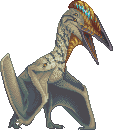
Spoiler
Constructed from sticks and branches and often oddly decorated, hattema bowers are impossible to miss. They reside most of the day in their bowers, waiting for dusk to hunt. Hattema will eat anything that moves; if it fits in their gaping jaws, it's food. They use weak illusions to startle prey and flush it out of hiding. Their four extra eyes allow them to see almost all around them, making them very difficult to attack despite being quite weak.
Spoiler
Magi Guron discovered these strange creatures on one of his many trips up and down the coastline between the Ixan jungle and Silva forest. Of course, the locals knew of the hattema, having long feared and respected them as soothsayers owing to their future-seeing eyes. Seeing is all their eyes do, but the humans don't know that and the hattema are happy to take their offerings anyway, giving flimsy "fortunes" and "advice" in return. But did Guron listen to the whisperings among the locals, whispers that people had disappeared while at the soothsayer's lair, before introducing some to the Keep and declaring such old and rare creatures needed conservation efforts? He hasn't been seen since going back.
Decription: Tekla
#1052 Ona's Skjoeldus (2,000g)

This egg peeps occasionally and smells strongly of fish.

Spoiler
A young skjoeldus hatches as large as most other adult penguins, but like other penguin hatchlings, depends heavily on its parents until it loses its baby down and can start to swim. Skjoeldi lack the brood flap that other large penguins use to keep their eggs warm, so instead they use magic to raise the ambient temperature of the air around them and keep the egg from freezing to the ground. They can use this ability for other eggs, too, and some who help raise these animals for the Preservationists Association have found ways to use their incubation magic to optimize conditions for creatures with fickle hatching conditions.

Spoiler
Skjoeldi range throughout the Borean coastline, darting between icebergs to catch their favorite food -- herring, icefish, and squid. Larger than any other penguin, they have to eat nearly fifty kilos of food daily to keep warm in the frigid waters, so when times are lean, they are unafraid of using their size to raid the nests of other penguins and ground-nesting birds. They'll even go after small seal rookeries, though they avoid those of the praluven seal, as even their large size is only a minor deterrent to such vicious predators. On the rare instances when they're not hunting, skjoeldi gather on rocky islands to tend to their eggs and chicks. They only lay one egg every few years in the wild, and always on the same guano-covered islands. Hunting of these birds for their meat and harvesting of their guano has diminished their numbers considerably in recent years, making their populations scant over their large range.
Spoiler
The skjoeldus is the largest bird north of Silva, at least on land. Taller than a man but otherwise resembling any other penguin, the creatures frequent the Borean coastline in the remote northern tundra. They are noted for their magical ability to warm things, though this is used almost exclusively for nesting, and no one has ever reported being attacked by it. In centuries past, these creatures were a favorite of northern fisherman and explorers, who hunted the skjoeldi for their rich meat and blubber, and harvested their guano to use as fertilizer. The slow growth of the creatures and their finicky breeding cycle soon caught up to early hunters, though, and eventually populations dwindled until they were thought to be extinct. Many of their nesting islands were destroyed by guano miners, making a population resurgence difficult. The discovery of a few individuals throughout their former range prompted quick action to save the species, and now special protected colonies have been established on a few remaining guano islands in the north. The Preservationists Association have also started to bring some of the animals into a specially-developed cold room at their facilities to study them and hopefully find better ways to manage the small remaining population.
Decription:PKGriffin
#1053 Thrishia's Sarcus (3,000g)

This egg has faint swirls on its shell.

Spoiler
A Sarcus hatchling cannot be left alone. Their random magic is just as powerful the day they are hatched as when they are adults, and any accidental bite or kick could have catastrophic consequences. Only talented magi raise these creatures, and anyone who owns one must keep it on a leash by their side at all times until they can demonstrate that it won’t suddenly attack someone. Sarcus have strong instincts to chase and bite, so individuals at the Keep know to always be wary around one of these hatchlings.

Spoiler
An adult Sarcus is a fearsome thing to behold. Their backs are well-muscled and their strong jaws are filled with rows of razor-sharp teeth. Their hooves are also sharp and hard and rough as rocks. They will constantly track movement, and if not trained, will lunge toward anything that gets too close. Despite all of this, a well-trained Sarcus is still a beneficial companion. A magi with a Sarcus guarding them will never be bothered. And a magi who doesn’t mind taking a few risks can try and find beneficial uses for their companion’s random magic effects from a bite or scratch. Some magi will even collect the liquid from their teeth to try and see what sorts of things may happen. In situations where no other magic works, sometimes trusting in a Sarcus’s random magic might give someone the solution they need.
Spoiler
Sarcus are vicious creatures, and also unmistakably magical. Their sharp hooves and teeth drip with a substance that has effects that only the creature itself seems to understand. A bite or scratch from a Sarcus can either result in poisoning or curing an already-poisoned individual, or perhaps something even stranger, like flowers growing from the wound or the bite victim suddenly being able to speak another language. Individuals in Triathe hunted these creatures nearly to extinction due to fear of their vicious natures combined with their distrust of magic. Some ancient legends even say these creatures were born from wayward magic from the mage wars, and that is why their bite seems to have such strange, unpredictable effects. Mage Thrishia found a small group of these creatures and brought them to the Keep, where many studies of their magic are ongoing.
Decription: Raneth
#1054 Lowenarc's Borean Rhino (4,500g)

This egg has a sharp horn.


m/f
Spoiler
Your tiny Rhino is affectionate when it first hatches. It’s also incredibly hungry most of the time. Borean Rhino hatchlings need vast amounts of food to maintain their energy. In the wild, hatchlings also need food to increase their fat reserves to combat the bitter cold of their home. At the Keep, without the constant pressure of the cold, these hatchlings simply turn their food into boundless energy. They will wear paths through the grass and even into the stones as the run around the Keep near constantly.
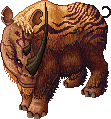
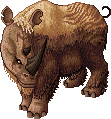
m/f
Spoiler
Adult Borean Rhinos have turned the energy from their younger ages into incredible strength. They are willful and can be stubborn, however. They will need intense training, not to mention good food-based motivation, to obey their magi’s orders. Once that is accomplished, however, they are among the best choices to pull carts through dangerous terrain. Whether it be magic or just pure strength, nothing can slow a Borean Rhino. They can travel at the same pace through thick snows, grabbing brambles, or over rocky, mountainous terrain. As long as they want to do the job they are given, nothing can stop them from completing it.
Spoiler
Rumors among those who lived in the tundra of Boreus described a fearsome beast that had the strength to plow through the deepest snows. Mage Lowenarc followed these rumors, tracking the elusive tales of the beast. The path led him to the coldest parts of Boreas, where the sun barely peered over the horizon in midwinter and cast strange patterns of golden light over the snow like golden imitations of the aurora overhead. These patterns of light helped camouflage the elusive Borean Rhino. There were not many of these creatures left in their native habitats, as the increasing cold had made their choice of food, hardy scrub brushes, scarce. Lowenarc brought back several to the Keep in order to preserve the species, and with the help of the herbalism guild, developed seeds that would withstand the cold in order to plant them and save the ones left behind. Now Borean Rhinos are a more common sight, and they plow paths for travelers in their cold, snowy homes.
Decription: Raneth







